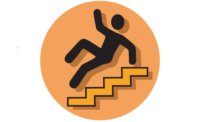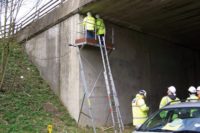By asking two basic questions, you can significantly simplify the process of implementing a program:
• Do I need fall protection? The first and most important question is whether you need a fall protection program. Employers have the duty of providing their workers with an environment free from recognized safety and health hazards. OSHA requires that fall protection be provided at: 4 feet in general industry; 5 feet in shipyards; 6 feet in the construction industry; 8 feet in longshoring operations; or any height when working over dangerous equipment and machinery. If you have workers working at or above these heights in the circumstances described, then you’re legally required to implement a suitable fall protection system.
• What kind of fall protection do I need? All fall protection programs begin with the ability to identify fall hazards. Once a fall hazard has been identified, there are generally two options: eliminate the hazard or provide protection against it. If the hazard cannot be eliminated, or prevented with guard rails or barriers, personal fall protection equipment including a harness, lanyard and retractable lifelines can be used.
Consider your options
Restraint systems keep workers from reaching an area where the fall hazard exists, or enable workers to perform their duties from the height required, while tied off to the system. You can restrain a worker by fitting them with a harness with a tether attached. A fixed-length lanyard is then attached to the D-ring on the harness, and then to a code-compliant anchorage system. Restraint is typically the preferred fall protection system when the environment allows, because a fall is completely avoided. Restraint systems, however, don’t tend to be very flexible once they’re in place, they don’t always handle multiple workers well, and the length of the system may be limited.
Wire rope systems require additional fall clearance due to the initial sag of the wire. The dynamic sag, or the stretch of the rope during a fall, adds to this distance. Rigid rail fall arrest systems eliminate any sag, stopping the fall in a much shorter distance than wire rope. Injuries occurring after the fall, such as swinging into obstacles, are minimized with a rigid rail fall arrest system, which stays firm and minimizes the total fall distance. When a worker falls on a wire rope system, the wire’s sag will make the trolley slide to the center of the nearest two supports, creating a risk for the worker to collide with nearby obstacles after a fall.
Fall arrest systems are available in multiple configurations, including various track profiles and support center distances, and can be easily customized to fit every budget and application.
Develop a detailed plan
If you have identified fall hazards in your environment, add fall protection to your company’s overall health and safety plan. Develop a site-specific program including detailed work procedures to protect your employees. The fall protection portion of your plan should state what measures are to be used, how they are to be used, and a rescue plan, as well as the individual responsible for overall supervision and training.
Remember these points and you’re on your way to a safer workplace.




